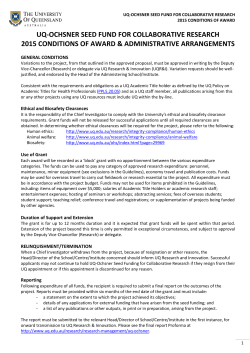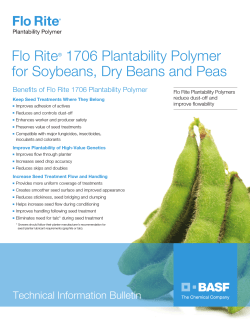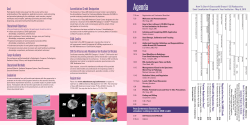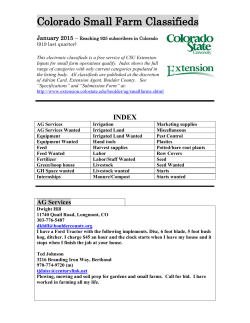
status of the comesa seed trade harmonisation regulations
STATUS OF THE COMESA SEED TRADE HARMONISATION REGULATIONS John Mukuka, PhD WHAT IS ACTESA? • A Specialised Agency of COMESA established by COMESA Heads of States . on 9th June 2009 . • Implement agricultural activities on staple foods with a focus on small scale farmers in the ESA region. • Stemmed from the need of having an implementing Agency for Comprehensive Africa Agricultural Development Programme (CAADP) pillars 2 on market access and 3 on Food Security • Programmes fits into CAADP regional compact framework’s priority 1 on Agricultural productivity and priority 2 on removal of barriers to trade STRATEGIC POSITION OF ACTESA? • COMESA is answerable to Members States' Heads of States and Governments in the Performance of . Regional Programmes • Use the COMESA Policy Organs to enable Member States implement Regional Programmes • Mutual and Collective Accountability and Responsibility • High level of Transparency, Responsibility, Coherence and Synergies STRATEGIC FOCUS OF ACTESA Mission Integrate Smallholder Farmers into National, Regional and International Markets through an improved Policy Environment and expanded Market Facilities /Services Focus Area one Policy Research Outreach and Advocacy Prioritysues: Trade Policy Investment Policy Sector-Specific Policies Research Stakeholder outreach Focus Area Two Focus Area Three Expanding Market Services and Facilities Capacity Building for Commercialization Priority Issues: •Productivity and technology adoption Development of farmer organisations Development of Farmer Organisations (CAADP pillar III) Market facilities and services, information system and service Forum (CAADP pillar II) ACTESA PRIORITIES / PROGRAMMES Agro-inputs: Seed Programme, Fertiliser standards and supply system, Biotechnology and Biosafety Policy Food security: Regional Food Balance Sheet, Cross Border Informal Trade monitoring, food safety, post harvest management, imports and exports bans, etc Market Access: Developed programme on maize and livestock for the COMESA region Strengthening Farmer Organisations: Not yet done, but scope in place EAC (ASARECA)- SADC- COMESA SEED HARMONISATION EAC COMESA Burundi Comoros DR Congo Djibouti Egypt Eritrea Ethiopia Kenya Libya Madagascar Malawi Mauritius Rwanda Seychelles Sudan Swaziland Uganda Zambia Zimbabwe SADC Angola Botswana DR Congo Lesotho Madagascar Malawi Mauritius Mozambique Namibia Swaziland Tanzania Zambia Zimbabwe South Africa Seychelles ASARECA Burundi EAC DRC Kenya Ethiopia Uganda Eritrea Tanzania Kenya Madagascar Burundi Rwanda Rwanda Sudan Comoros Tanzania Djibouti Uganda Egypt Libya COMESA ASARECA SADC BENEFITS OF COMESA SEED SYSTEMS •Seed companies’ will benefit from reduced business costs as they will no need to set new . branching across the region •The time and cost of certification / inspection of quarantine pests will be reduced and seed companies •The incomes and/or numbers of smallholder outgrower small seed producers will increase as they join regional value chains, expanding their production on behalf of national, regional or international seed companies. BENEFITS OF HARMONISED REGULATIONS •Smallholder farmers will benefit from increased availability of a wide range of new and improved seed varieties at . affordable prices, •thus increasing their the small-holder productivity as seed of consistent good quality will be traded in the COMESA region •Domestication will encourage innovation by seed companies through Research and Development (R & D) that will reduce costs of doing seed business in region •Increase in numbers of local seed producers as they will be increased demand for quality seed and will foster partnership among seed companies 11 CROPS COMMON IN BOTH THE COMESA AND SADC CROP –COMESA LIST ONLY CROPS –SADC LIST ONLY MAIZE (OPV and Hybrid) PEARL MILLET CABBAGE GROUNDNUT ONION SOYABEAN PEPPER COTTON (OPV and Hybrid) TOMATO SUNFLOWER (OPV and hybrid) TOBACCO RICE (OPV and Hybrid) PEA BEAN SORGHUM (OPV and Hybrid) WHEAT CASSAVA POTATO 10CROPS COMMON IN BOTH THE COMESA AND EAC CROP –COMESA LIST ONLY MAIZE (OPV and Hybrid) PEARL MILLET GROUNDNUT COTTON (OPV) SOYABEAN SUNFLOWER (OPV and hybrid) RICE (OPV and Hybrid) BEAN SORGHUM (OPV and Hybrid) WHEAT CASSAVA IRISH POTATO 8 CROPS COMMON IN BOTH THE COMESA AND ECOWAS CROP –COMESA LIST ONLY CROPS – ECOWAS LIST ONLY MAIZE (OPV AND HYBRID) SUNFLOWER (OPV AND HYBRID) COWPEA GROUNDNUT SOYABEANS YAM SORGHUM (OPV AND HYBRID) WHEAT ONION COTTON TOMATOS CASSAVA PEARL MILLET RICE (OPV AND HYBRID) IRISH POTATO BEANS IMPLEMENTATION STATUS •COMESA Seed Harmonisation Regulations were . are now in force and are gazetted in May, 2014 and bidding according to article 10(1) of the Treaty •With the directive from COMESA Council of Ministers in February, 2014, ACTESA has come up with COMESA Seed Harmonisation Implementation Plan (COMSHIP) validated in April, 2014 •The COMSHIP was endorsed by the COMESA Ministers of Agriculture in February, 2015. COMSHIP VISION A 5 YEAR STRATEGY TO IMPLEMENT COMESA SEED TRADE HARMONISATION REGULATIONS, LEADING TO INCREASED SEED PRODUCTION, RELIABILITY, TRADE AND COMPETITIVENESS OF THE SEED INDUSTRY IN THE COMESA REGION.” COMSHIP IN A NUTSHELL •SO.1. Prepare for, and support of Phased . domestication of seed regulations •SO. 2. Strengthen awareness of the COMESA Seed Trade Harmonisation regulations •SO.3. Monitor and improvement of the COMESA Seed Trade Harmonisation Regulations •SO. 4. COMESA Seed Capacity Building and Smallholder Support Programme PARNERSHIPS WITHIN COMSHIP COMESA / ACTESA Secretariat: Facilitation , Co-ordination and Communication Contracting /Facilitation DEVELOPMENT PARTNERS Technical Support and Resource Mobilization (UKAID and USAID) IMPLEMENTING PARTNER (AFSTA, SACAU, EAFF and other NGOs GOVERNMENTS / MEMBER STATES: Facilitate activities by national partners in collaboration with ACTESA (NSAs, NPPOs, NAROS, etc WITH FOOD TRADE / UKAID SUPPORT •Assist Burundi and Rwanda in finalising draft Seed Laws and align them to the COMESA Seed Trade Harmonisation . Regulations (SO. 1) •Align the National Seed Regulatory Systems in Kenya, Malawi, Uganda, Zambia and Zimbabwe to the COMESA Seed Trade Harmonisation Regulations (SO. 1) •Strengthen Institutional and human capacities in targeted countries (SO. 1) •Launch COMSHIP and conduct effective advocacy, awareness creation, information sharing and learning in relation to the COMESA Seed Trade Harmonisation Regulations (SO. 2& 3) •Establish Mechanisms for regional variety release and maintenance of variety catalogue (SO. 1) WITH USAID SUPPORT •Far launched COMSHIP in Swaziland, DR Congo, Ethiopia, Egypt, Madagascar and Sudan (SO.2) •Assist DR Congo, South Sudan . and Djibouti in finalising draft Seed Laws and align them to the COMESA Seed Trade Harmonisation Regulations (SO. 1) •Align the National Seed Regulatory Systems in Ethiopia to the COMESA Seed Trade Harmonisation Regulations (SO. 1) •Training of customs staff on the COMESA Seed Trade Harmonisation Regulations and documentation (SO. 1) •Awareness and training on Maize Lethal Necrosis Disease (MLD) for Burundi, Djibouti, Ethiopia, Uganda, Rwanda, Kenya, Zambia, Malawi (SO. 2 & 3) •Support operalitionalisation of the COMESA Seed Committee (SO. 1) WITH AGRA-SSTP SUPPORT •Development of the software and hardware of the COMESA regional variety release and maintenance of variety catalogue . (SO. 1) CONCLUSIONS •ALIGNMENT TO THE COMESA SEED TRADE HARMONISATION REGULATIONS THROUGH . “REVIEW TEAM” KEY •THE SUPPORT OF THE NATIONAL SEED AUTHORITY / NATIONAL PLANT PROTECTION ORGANISATION IS CORNERSTONE •AWARENESS CREATION IMPORTANT TO ALL SEED STAKEHOLDERS •PRIVATE PUBLIC PARTNERSHIP IS ESSENTAIL ELEMENT AS WAS DONE IN THE PAST CONCLUSIONS •OPERATIONALISATION OF THE COMESA VARIETY CATALOGUE CRITICAL . •A FUNCTIONAL COMESA SEED COMMITTEE ALSO IMPORTANT •BY 2050, WORLD POPULATION WILL BE 9.3 BILLION, THE REGION HAS POTENTIAL TO FEED THE WHOLE WORLD, THIS IS THE TIME. THANK YOU
© Copyright 2025










